Want More Out Of Life?
Do you often wonder how to be more successful, have [tag-tec]better relationships[/tag-tec], or just get more of what you want out of life? Do you [tag-tec]want to be happier[/tag-tec] and have more peace of mind?
Thinking about these things, wanting them and not knowing how to actually get them can lead to high levels of stress and frustration. That’s the bad news, but don’t worry because there’s also good news. There are things you can do, steps you can take, that will help reduce your stress and lead you toward a much happier more peaceful life.
“The Constitution only guarantees the American people the right to pursue happiness. You have to catch it yourself.” ~ Benjamin Franklin
What Are You Thinking about?
In order to clearly understand what is causing [tag-tec]stress[/tag-tec] in your life, you must begin by listening to yourself closely. Every thought that passes through your mind has an impact. Common thoughts such as, “How will I get this work done?” or “I don’t know how I will pay my bills this month.” or “What if someone I love becomes ill?” leave a mark as they pass through. That mark is evidenced by the stress you feel.
All of these stressful thoughts can be turned around so that you can focus on the positive. Instead of wondering, “How will I get this work done?” you could ask yourself, “How much work can I get accomplished today?” and then decide on a realistic answer. This sets you up to meet expectations, rather than fall short.
Imagine [tag-tec]worrying[/tag-tec] about what would happen if someone you love becomes ill. How would you feel? Now imagine focusing on spending a lot of quality time with the people you love. How would that feel? Most worries are focused on some future event you don’t want to happen or things you wish you could change about the past.
Worry Worry Who’s Got the Worry?
It’s unrealistic to think we’ll stop worrying altogether. But, constantly thinking those “what if” and “I should…” thoughts are truly harmful to your happiness. Worry causes stress, stress causes agitation, and agitation makes you worry more. It’s a downward spiral, and one that has major negative effects on your emotional, mental, and physical well-being.
Unless you can learn to break the worry cycle, the discomfort, confusion, disappointment, and pain that are caused by your everyday unexamined thoughts will continue to be your day to day companion and keep you from feeling happy.
While it’s very normal for us to worry–with practice–that same worry cycle could be turned into a productive process. This process can propels us towards positive change and moves us to another level of happiness.
Take a good look at how you interact with the world. Take some time to reflect on how you face problems and tackle them. Does sitting around worrying ever seem to help your situation? Breaking the cycle is critical.
Breaking Free From Worry
Genuine happiness is only around the corner, but developing the skills and techniques to help reframe the negative and worrisome thoughts that detour your happiness is essential. Breaking free from worry and escaping the vicious cycle is possible, if you’re willing to stop, examine, and then revise your “what if” and “if only” thoughts. It’s like breaking any bad habit–it can be done, with a commitment and some practice.
Here you’ll find a three-step plan that can quickly turn things around and lead you toward a more rewarding, peaceful, and happy life:
Notice Feelings
The first step is to notice when you’re feeling uncomfortable in any way. Contrary to what you might think, your thoughts cause your feelings, but often times we think so many things–so quickly–that it’s challenging to notice individual thoughts.
This is why the very first thing to do is to begin noticing when you feel uncomfortable. At this point your worry becomes a helpful friend. Worry inevitably makes us feel uneasy, this discomfort can be used as a warning bell to stop and discover what you’re thinking in that moment. Managing your worries and making changes can start by simply noticing how you’re feeling.
Flip It – “Don’t Want” into “Do Want”
Worry usually takes the form of what you don’t want. Now it’s time to figure out what you actually do want. When you find yourself thinking “How will I get this work done?” it’s time to discover what you do want at a core level that has you think that thought in the first place. When you examine this thought you might realize that you truly value productivity and what you do want is to be more effective and get things finished in a timely manner.
Now What? Take Action!
Once you’ve identified the essence of what you really want, don’t stop there, it’s now time to take action. Deciding what actions to take is the next step.
You’ve determined that what you do want is to be more effective and get things done in a timely manner. Remember, worrying about what will happen in the future or fear of repeating a past mistake is what keeps you stuck in the worry cycle. Stay in the present moment. And ask yourself; “What can I do in this moment to be more effective?” “What action can I take right now that will move you closer to getting something finished?”
Each and every small step you take moves you closer to what you do want .Once you get moving in this direction, you’ll find that the process takes on a power of its own, gently releasing you from the tight grip of stress and worry and pointing you in the direction of that peace and happiness you long for. Because, when you’re in action there just isn’t that much time to be worried.











